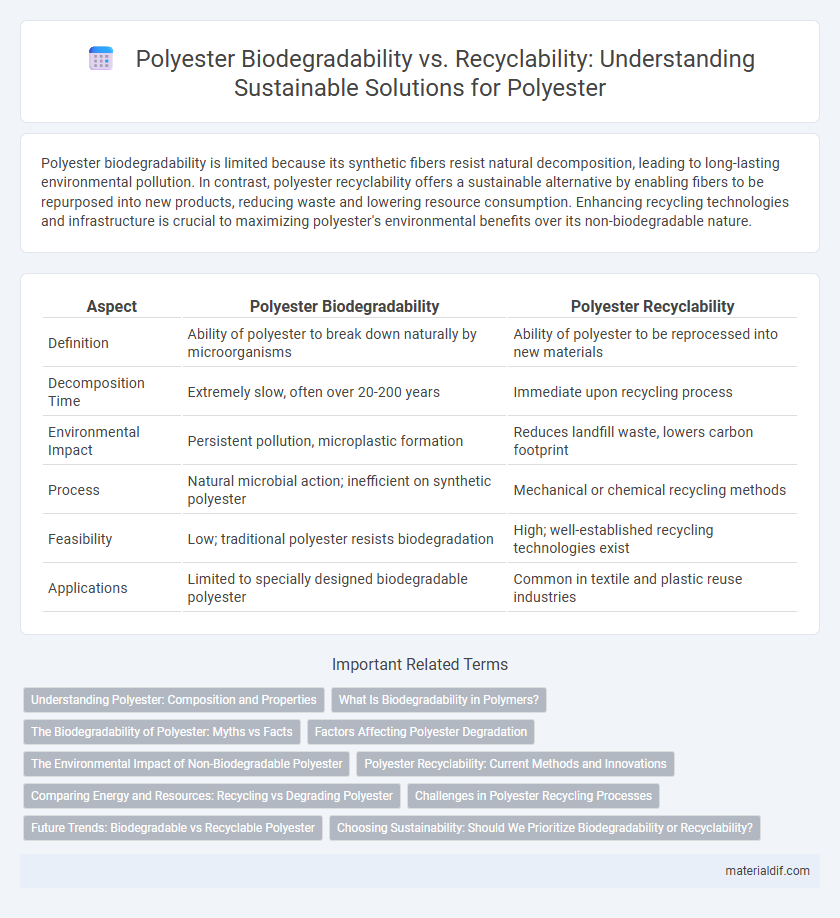Polyester biodegradability is limited because its synthetic fibers resist natural decomposition, leading to long-lasting environmental pollution. In contrast, polyester recyclability offers a sustainable alternative by enabling fibers to be repurposed into new products, reducing waste and lowering resource consumption. Enhancing recycling technologies and infrastructure is crucial to maximizing polyester's environmental benefits over its non-biodegradable nature.
Table of Comparison
| Aspect | Polyester Biodegradability | Polyester Recyclability |
|---|---|---|
| Definition | Ability of polyester to break down naturally by microorganisms | Ability of polyester to be reprocessed into new materials |
| Decomposition Time | Extremely slow, often over 20-200 years | Immediate upon recycling process |
| Environmental Impact | Persistent pollution, microplastic formation | Reduces landfill waste, lowers carbon footprint |
| Process | Natural microbial action; inefficient on synthetic polyester | Mechanical or chemical recycling methods |
| Feasibility | Low; traditional polyester resists biodegradation | High; well-established recycling technologies exist |
| Applications | Limited to specially designed biodegradable polyester | Common in textile and plastic reuse industries |
Understanding Polyester: Composition and Properties
Polyester, primarily composed of polyethylene terephthalate (PET), exhibits limited biodegradability due to its strong molecular bonds and synthetic origin, making natural decomposition a lengthy process. Its recyclability is significantly higher, as PET can be mechanically or chemically recycled into new fibers or packaging materials, reducing environmental impact. The polymer's durability and resistance to environmental factors contribute to both its persistence in ecosystems and its suitability for multiple recycling cycles.
What Is Biodegradability in Polymers?
Biodegradability in polymers refers to the ability of polyester materials to be broken down by microorganisms into natural substances such as water, carbon dioxide, and biomass. This process varies significantly among different types of polyester, with conventional polyethylene terephthalate (PET) showing limited biodegradability compared to newer, bio-based variants designed for enhanced environmental decomposition. Understanding biodegradability is crucial for assessing the environmental impact and lifecycle management of polyester products versus their recyclability options.
The Biodegradability of Polyester: Myths vs Facts
Polyester is often misunderstood in terms of biodegradability, with many myths suggesting it naturally decomposes quickly; in reality, conventional polyester is a synthetic polymer that can take hundreds of years to break down in natural environments. Scientific studies show that polyester biodegradation only occurs under specific industrial composting conditions involving high temperatures and microbial activity, not in typical soil or marine settings. Innovations in bio-based polyesters, such as polylactic acid (PLA), are emerging as more eco-friendly alternatives due to their enhanced biodegradability compared to traditional petroleum-derived polyester.
Factors Affecting Polyester Degradation
Polyester degradation is influenced by factors such as exposure to UV light, temperature, moisture, microbial activity, and chemical environment, which determine its biodegradability and recyclability. Biodegradable polyester variants contain additives or copolymers enhancing microbial breakdown, while conventional polyester resists degradation but is highly recyclable through mechanical or chemical processes. Environmental conditions and polymer structure complexity critically affect the rate and extent of polyester degradation in natural and industrial settings.
The Environmental Impact of Non-Biodegradable Polyester
Non-biodegradable polyester significantly contributes to persistent environmental pollution due to its resistance to natural degradation processes, leading to accumulation in landfills and oceans. Its production and disposal release microplastics that threaten marine ecosystems and biodiversity, posing long-term ecological risks. Recycling polyester reduces waste by reprocessing fibers into new materials, but the limited recycling infrastructure and contamination challenges impede widespread adoption.
Polyester Recyclability: Current Methods and Innovations
Polyester recyclability primarily involves mechanical and chemical recycling methods, with mechanical recycling shredding and melting polyester fibers to create new textiles, while chemical recycling breaks down polymers into monomers for repolymerization. Innovations include enzymatic and solvolysis processes that enhance the efficiency and purity of recycled polyester, reducing environmental impact compared to traditional methods. Advances in sorting technologies and closed-loop recycling systems are improving polyester recovery rates, promoting sustainability in the textile industry.
Comparing Energy and Resources: Recycling vs Degrading Polyester
Recycling polyester consumes significantly less energy compared to producing new fibers from raw materials, reducing overall resource depletion and carbon emissions. Biodegrading polyester, however, typically requires specialized conditions and extended timeframes, offering limited immediate energy savings and potentially generating microplastics. Emphasizing recycling processes enhances resource efficiency and supports circular economy practices, while biodegradability addresses long-term environmental concerns under controlled degradation environments.
Challenges in Polyester Recycling Processes
Polyester recycling faces significant challenges due to contamination from dyes, additives, and mixed polymer blends that complicate separation and reduce material quality. Chemical recycling methods, such as glycolysis and hydrolysis, require high energy input and generate emissions, limiting their environmental benefits. Mechanical recycling often leads to polymer degradation, affecting the length and strength of fibers, which restricts the reuse of recycled polyester in high-performance applications.
Future Trends: Biodegradable vs Recyclable Polyester
Biodegradable polyester offers a promising solution to plastic pollution by breaking down naturally, reducing long-term environmental impact, while recyclable polyester supports circular economy models by enabling repeated material reuse. Recent advancements focus on developing bio-based polymers that maintain performance standards yet enhance compostability, contrasting with innovations in chemical recycling methods that allow recovery of high-quality polyester fibers. Future trends indicate a dual approach where next-generation textiles integrate both biodegradability and recyclability to meet sustainability goals in the fashion and packaging industries.
Choosing Sustainability: Should We Prioritize Biodegradability or Recyclability?
Polyester recyclability offers a practical solution to reducing textile waste by enabling the material to be reprocessed into new products multiple times, significantly lowering environmental impact compared to single-use items. Biodegradable polyester, although promising in breaking down naturally, often requires specific industrial composting conditions that are not widely accessible, limiting its effectiveness in real-world scenarios. Prioritizing recyclability in polyester supports a circular economy model, enhancing resource efficiency and minimizing landfill accumulation, making it a more scalable and impactful choice for sustainable development.
Polyester Biodegradability vs Polyester Recyclability Infographic

 materialdif.com
materialdif.com